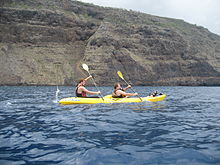 A sea kayak or touring kayak is a kayak developed for the sport of paddling on open waters of lakes, bays, and the ocean. Sea kayaks are seaworthy small boats with a covered deck and the ability to incorporate a spraydeck. They trade off the maneuverability of whitewater kayaks for higher cruising speed, cargo capacity, ease of straight-line paddling, and comfort for long journeys.
A sea kayak or touring kayak is a kayak developed for the sport of paddling on open waters of lakes, bays, and the ocean. Sea kayaks are seaworthy small boats with a covered deck and the ability to incorporate a spraydeck. They trade off the maneuverability of whitewater kayaks for higher cruising speed, cargo capacity, ease of straight-line paddling, and comfort for long journeys.
Sea kayaks are used around the world for marine (sea) journeys from a few hours to many weeks, as they can accommodate one to three paddlers together with room for camping gear, food, water, and other supplies. A sea kayak usually ranges anywhere from 10–18 feet (3–5½ meters) for solo craft, and up to 26 feet (8 meters) for tandem craft. Width may be as little as 21″ (50 cm), and may be up to 36″ (90 cm).
Safety
A sea kayak’s primary safety device is its paddler. Although some kayakers consider a well-practised self-righting move such as an Eskimo roll to be essential to safe open-water kayaking, it is the technique of bracing that every well-trained, experienced kayaker practises to maintain an upright position in their kayak. Practice in bracing is often neglected by inexperienced kayakers once they have learned the Eskimo roll. However, the reality is that having to roll really means having to recover from a failed brace. Being in the capsized position in some environments due to missing a brace can put the paddler in danger of colliding with obstacles under the water. Staying upright in surf zones, rock gardens, and rivers is most important and is only accomplished through well practised and successful bracing.
While there are a number of techniques for unassisted righting and re-entry of a kayak after a capsize, most paddlers consider it safest to paddle with one or more others, as assistance is useful if attempting to roll up solo fails. Even if the assistance fails to get you righted, it’s a lot easier to climb back into a boat in the open sea if you’ve got another boat and paddler to help and your boat’s been emptied of water first. Nonetheless, experienced paddlers do attempt open water crossings unaccompanied, and several major long-distance kayak expeditions have been carried out solo.
The use of a Paddle float self rescue device, generally consisting of foam, or inflatable bag, attached to the end of a paddle, allows a paddler to use the paddle as an outrigger, while climbing back into the cockpit. Be sure if you use an inflatable paddle float that you use a dual chambered model, but only train with one chamber inflated. A double chambered device will give you redundancy in case of a failure in one chamber. Training with one chamber inflated won’t leave you handicapped if one chamber does fail. This fairly reliable rescue technique, if well practised, allows one to paddle with confidence when not equipped with a ‘bombproof’ roll.
There is a strong culture of self-sufficiency amongst sea kayakers and extensive safety equipment such as compass, towing lines, manual pumps, repair kits including wet application repair tape, flares, paddle leash, spare paddles, and survival gear are routinely carried; along with supplies of food and a flask of non-caffeinated beverage for non-emergency use. GPS, charts, lights, radios and cell phones, and radar reflectors are also sometimes carried.
